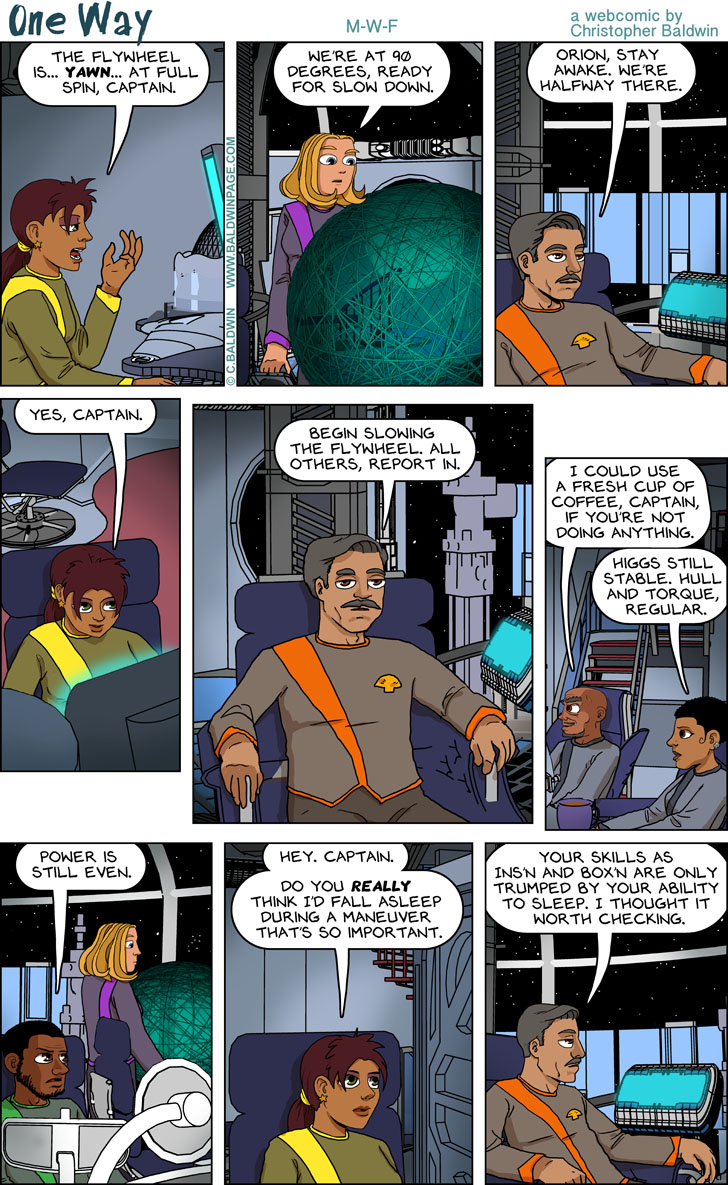
June’s here already? Ay-yi-yi.
Had a fine weekend. We walked around town. Saw my friend Sherry read from her new book of poetry, Deep Kiss. We made a batch of vegan cheese, some muffins.
After about a month of my new novel being stalled (a chapter I just couldn’t figure out), I finally DID figure it out and wrote it on Friday, and it came out well. I’m very happy to have the tub unplugged. Except the next chapter might be a difficult one too. Hrm.

















It’s not like she’s slept through anything else critical before, with any real gravity.
Yes, it’s already June but “someone” is yet to finish Spacetrawler :/
Don’t make me turn my adblocker on you!!
What is that image in the globe in the second panel? If you filter out the yarn-ball effect it looks like a dock at night with a large moon behind it.
WTF is an “Ins’n & Box’n”?
@KBowz, that’s the ship’s navigational display. We’re all still wondering what the green rubber bands represent. Maybe slipstream pathways…?
@Duke, you’ll just have to go back to the beginning of the strip and read Christopher’s “liner notes”. Unfortunately, due to an irrecoverable error, all of the early reader comments have reverted to electronic dust. Still, Christopher has left enough breadcrumbs that you should be able to find descriptions of all these new and exciting starship crew positions.
You know what’s really weird? I read Nukees and in that comic, there just so happened to be a gigantic rubber band ball in today’s update!
Not only that, but I go through my comics list in alphabetical order, so I read a comic about a giant rubber band ball in black and white, only to see a display that resembles a giant rubber band ball in full color.
Chris, you and Gav on Nukees are trippin’ me out, man!
It looks like a 3D version of an Armillary Sphere for the future.
—
Despite the fact that the term “armillary sphere” sounds like a high-tech weapon or something from a science fiction movie, it is neither. An armillary sphere is an old tool that is supposed to represent the heavens. They were models of what scientists thought the heavens looked like and how they were suppose to have moved. The armillary sphere is also known as the spherical astrolabe, the armilla, or the armil. The armillary sphere is related to the astrolabe, which was a navigation tool used for determining the position of the Sun and stars and used by sailors for navigating.
The armillary sphere was invented hundreds of years ago. The identity of who created the sphere has been debated. Some credit its invention to a Greek named Eratosthenos. Others have said that the Chinese or other Greek scholars invented it. Regardless of its inventor, the armillary sphere is one of the oldest astronomical instruments in the world. In addition to its being used in the Greek world, the armillary sphere was also used throughout Asia and the Islamic Empire.
These devices were used as teaching tools and models. The models were used to show the difference between the Ptolemaic and Copernican theories of the Solar System. In the Copernican theory, the Sun is the center of our Solar System, while the Earth is the center of the Solar System according to the Ptolemaic theory. When armillary spheres were first invented, the Ptolemaic theory was still the accepted view. It was soon after armillary spheres were invented that Copernicus set forth his theory of the Sun as the center of the Solar System, although it was not widely accepted until centuries later.
Read more: http://www.universetoday.com/40702/armillary-sphere/#ixzz33WaOKiGF
I don’t think that’s how flywheels work. A change in momentum causes a force on the ship, so as it spins up the ship will rotate. But if you simply start slowing the flywheel down, the change in momentum will be in the opposite direction, causing the ship to spin back to its original heading. I think you need some other (potentially weaker) force to counteract that effect as you de-saturate the flywheel, spinning it down slowly. Then you could spin it up again to complete the maneuver. In satellites, reaction wheels (basically a flywheel) are used for quick maneuvers, and the torque rods, which drag against the earths magnetic field to create small amounts of torque, are employed while desaturating the reaction wheels.
why wouldn’t maneuvering thrusters work in the Higgs bubble?
Hazelrah, no, that’s how reaction wheels work. As you say, a torque on the flywheel by the ship will cause them both to rotate in opposite directions (with the total angular momentum remaining 0). But stopping the flywheel by applying a torque in the opposite direction simply causes the ship’s angular moment to also return to zero, regardless of what its current heading is. Momentum is conserved, but not orientation. As Wikipedia says, “reaction wheels work around a nominal zero rotation speed” —which stays zero as long as there are no external torques.